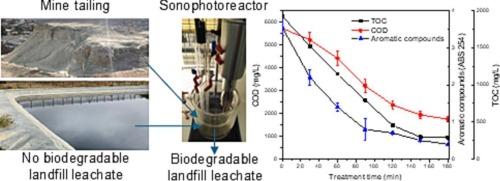Proposing a circular economy for mine tailings: using them as catalysts in the treatment of landfill leachate
IF 5
2区 工程技术
Q1 ENGINEERING, CHEMICAL
引用次数: 0
Abstract
Mine tailings (MT), a significant by-product of the mining industry, pose environmental risks due to their metal content and social hazards when they are located near urban areas. However, their mineral composition, rich in feldspars, quartz, phyllosilicates, and TiO2, offers potential for reuse within a circular economy framework. In this context, this study evaluates the catalytic application of MT in a sonophotocatalytic process to treat mature landfill leachate (LL), a recalcitrant effluent with low biodegradability. Using a full factorial design, the effects of catalyst load, hydrogen peroxide concentration, and pH of the solution on the removal of total organic carbon (TOC), Chemical Oxygen Demand and aromatic compounds (Abs254) of the landfill leachate were assessed. Optimal conditions (2000 mg/L MT, 3000 mg/L H2O2, pH 3) led to 29.8 % and 50.2 % removal of TOC and aromatic compounds, respectively. Under these optimized physicochemical conditions applied for 3 h of treatment, the removal of TOC, COD, and aromatic compounds was 84.9 %, 69.6 %, and 88.7 %, respectively.
The biodegradability of treated landfill leachate improved significantly, exceeding 80 % in the Zahn-Wellens test, with no detectable leaching of metals from the catalyst. These findings demonstrate the feasibility of repurposing MT as photocatalysts for landfill leachate treatment, offering a sustainable solution to two pressing waste streams.

提出尾矿循环经济:利用尾矿作为处理垃圾渗滤液的催化剂
尾矿是采矿业的重要副产物,由于其金属含量高,在城市附近存在环境风险和社会危害。然而,它们富含长石、石英、层状硅酸盐和二氧化钛的矿物成分,在循环经济框架内提供了再利用的潜力。在此背景下,本研究评估了MT在声光催化过程中对成熟垃圾渗滤液(LL)的催化应用,LL是一种生物降解性低的难降解废水。采用全因子设计,考察了催化剂用量、过氧化氢浓度和溶液pH对垃圾渗滤液中总有机碳(TOC)、化学需氧量(cod)和芳香族化合物(Abs254)去除率的影响。最佳条件为MT 2000 mg/L, H2O2 3000 mg/L, pH 3, TOC去除率为29.8%,芳香族化合物去除率为50.2%。在优化后的理化条件下处理3 h, TOC、COD和芳香族化合物的去除率分别为84.9%、69.6%和88.7%。
本文章由计算机程序翻译,如有差异,请以英文原文为准。
求助全文
约1分钟内获得全文
求助全文
来源期刊

Minerals Engineering
工程技术-工程:化工
CiteScore
8.70
自引率
18.80%
发文量
519
审稿时长
81 days
期刊介绍:
The purpose of the journal is to provide for the rapid publication of topical papers featuring the latest developments in the allied fields of mineral processing and extractive metallurgy. Its wide ranging coverage of research and practical (operating) topics includes physical separation methods, such as comminution, flotation concentration and dewatering, chemical methods such as bio-, hydro-, and electro-metallurgy, analytical techniques, process control, simulation and instrumentation, and mineralogical aspects of processing. Environmental issues, particularly those pertaining to sustainable development, will also be strongly covered.
 求助内容:
求助内容: 应助结果提醒方式:
应助结果提醒方式:


